Oven
An oven is a thermally insulated chamber used for the heating, baking, or drying of a substance,[1] and most commonly used for cooking. Kilns and furnaces are special-purpose ovens used in pottery and metalworking, respectively.
_005.jpg)
History
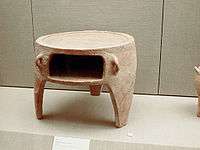
The earliest ovens were found in Central Europe, and date back to 29,000 BC. They were roasting and boiling pits inside yurts used to cook mammoth.[2] In Ukraine from 20,000 BC they used pits with hot coals covered in ashes. The food was wrapped in leaves and set on top, then covered with earth.[3] In camps found in Mezhirich, each mammoth bone house had a hearth used for heating and cooking.[4] Ovens were used by cultures who lived in the Indus Valley and in pre-dynastic Egypt.[5][6] By 3200 BC, each mud-brick house had an oven in settlements across the Indus Valley.[5][5][7] Ovens were used to cook food and to make bricks.[5] Pre-dynastic civilizations in Egypt used kilns around 5000–4000 BC to make pottery.[6]
During the Middle Ages, instead of earth and ceramic ovens, Europeans used fireplaces in conjunction with large cauldrons. These were similar to the Dutch oven. Following the Middle-Ages, ovens underwent many changes over time from wood, iron, coal, gas, and even electric. Each design had its own motivation and purpose. The wood-burning stoves saw improvement through the addition of fire chambers that allowed better containment and release of smoke. Another recognizable oven would be the cast-iron stove. These were first used around the early 1700s when they themselves underwent several variations including the Stewart Oberlin iron stove that was smaller and had its own chimney.[8]
In the early part of the 19th century, the coal oven was developed. It was cylindrical in shape and made of heavy cast iron. The gas oven saw its first use as early as the beginning of the 19th century as well. Gas stoves became very common household ovens once gas lines were available to most houses and neighborhoods. James Sharp patented one of the first gas stoves in 1826. Other various improvements to the gas stove included the AGA cooker invented in 1922 by Gustaf Dalén. The first electric ovens were invented in the very late 19th century, however, like many electrical inventions destined for commercial use, mass ownership of electrical ovens could not be a reality until better and more efficient use of electricity was available.[8]
More recently, ovens have become slightly more high-tech in terms of cooking strategy. The microwave as a cooking tool was discovered by Percy Spencer in 1946, and with the help from engineers, the microwave oven was patented.[8] The microwave oven uses microwave radiation to excite the molecules in food causing friction, thus producing heat.[9]
Types of ovens
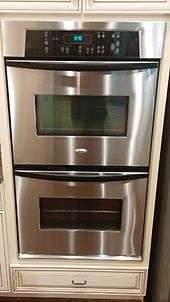
- Double oven: a built-in oven fixture that has either two ovens,[10][11] or one oven and one microwave oven. It is usually built into the kitchen cabinet.
- Earth oven: An earth oven is a pit dug into the ground and then heated, usually by rocks or smoldering debris. Historically these have been used by many cultures for cooking. Cooking times are usually long, and the process is usually cooking by slow roasting the food. Earth ovens are among the most common things archaeologists look for at an anthropological dig, as they are one of the key indicators of human civilization and static society.[12]
- Ceramic oven: The ceramic oven is an oven constructed of clay or any other ceramic material and takes different forms depending on the culture. The Indians refer to it as a tandoor, and use it for cooking. They can be dated back as far as 3,000 BC, and they have been argued to have their origins in the Indus Valley.[6] Brick ovens are also another ceramic type oven. A culture most notable for the use of brick ovens is Italy and its intimate history with pizza. However, its history also dates further back to Roman times, wherein the brick oven was used not only for commercial use but household use as well.[13]
- Gas oven: One of the first recorded uses of a gas stove and oven referenced a dinner party in 1802 hosted by Zachaus Winzler, where all the food was prepared either on a gas stove or in its oven compartment. In 1834, British inventor James Sharp began to commercially produce gas ovens after installing one in his own house. In 1851, the Bower's Registered Gas Stove was displayed at the Great Exhibition. This stove would set the standard and basis for the modern gas oven. Notable improvements to the gas stove since include the addition of the thermostat which assisted in temperature regulation; also an enamel coating was added to the production of gas stoves and ovens in order to help with easier cleaning.[14]
- Masonry oven: Masonry ovens consist of a baking chamber made of fireproof brick, concrete, stone, or clay. Though traditionally wood-fired, coal-fired ovens were common in the 19th century. Modern masonry ovens are often fired with natural gas or even electricity, and are closely associated with artisanal bread and pizza. In the past, however, they were also used for any cooking task that required baking.
- Microwave oven: An oven that cooks food using microwave radiation rather than infrared radiation (typically a fire source). Conceptualized in 1946, Dr. Percy Spencer allegedly discovered the heating properties of microwaves while studying the magnetron. By 1947, the first commercial microwave was in use in Boston, Mass.[15]
- Toaster oven: Toaster ovens are small electric ovens with a front door, wire rack and removable baking pan. To toast bread with a toaster oven, slices of bread are placed horizontally on the rack. When the toast is done, the toaster turns off, but in most cases the door must be opened manually. Most toaster ovens are significantly larger than toasters, but are capable of performing most of the functions of electric ovens, albeit on a much smaller scale.
- Wall oven: Wall ovens make it easier to work with large roasting pans and Dutch ovens. A width is typically 24, 27, or 30 inches. Mounted at waist or eye level, a wall oven eliminates bending. However, it can be nested under a countertop to save space. A separate wall oven is expensive compared with a range.[16]
- Deck oven
- Rotary oven
- Steam oven
- Convection oven
- Tunnel oven
- A ceramic oven
- Stove bench in a German farm's living room
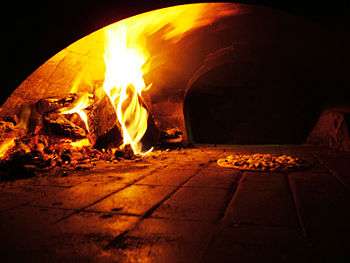 A wood-fired pizza oven, a type of masonry oven
A wood-fired pizza oven, a type of masonry oven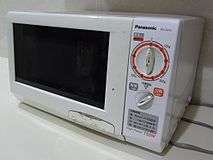
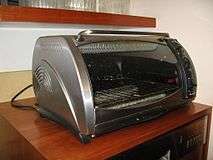
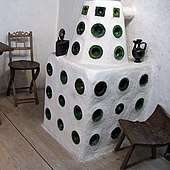 Traditional clay stove from Serbia (Ethnographic Museum, Belgrade)
Traditional clay stove from Serbia (Ethnographic Museum, Belgrade)
Cooking
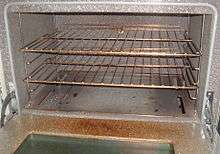
In cooking, the conventional oven is a kitchen appliance used for roasting and heating. Foods normally cooked in this manner include meat, casseroles and baked goods such as bread, cake and other desserts. In modern times, the oven is used to cook and heat food in many households across the globe.
Modern ovens are typically fueled by either natural gas or electricity, with bottle gas models available but not common. When an oven is contained in a complete stove, the fuel used for the oven may be the same as or different from the fuel used for the burners on top of the stove.
Ovens usually can use a variety of methods to cook. The most common may be to heat the oven from below. This is commonly used for baking and roasting. The oven may also be able to heat from the top to provide broiling (US) or grilling (UK/Commonwealth). A fan-assisted oven that uses a small fan to circulate the air in the cooking chamber, can be used.[17][18] Both are also known as convection ovens. An oven may also provide an integrated rotisserie.
Ovens also vary in the way that they are controlled. The simplest ovens (for example, the AGA cooker) may not have any controls at all; the ovens simply run continuously at various temperatures. More conventional ovens have a simple thermostat which turns the oven on and off and selects the temperature at which it will operate. Set to the highest setting, this may also enable the broiler element. A timer may allow the oven to be turned on and off automatically at pre-set times. More sophisticated ovens may have complex, computer-based controls allowing a wide variety of operating modes and special features including the use of a temperature probe to automatically shut the oven off when the food is completely cooked to the desired degree.
Cleaning
Some ovens provide various aids to cleaning. Continuous cleaning ovens have the oven chamber coated with a catalytic surface that helps break down (oxidize) food splatters and spills over time. Self-cleaning ovens use pyrolytic decomposition (extreme heat) to oxidize dirt. Steam ovens may provide a wet-soak cycle to loosen dirt, allowing easier manual removal. In the absence of any special methods, chemical oven cleaners are sometimes used or just scrubbing.
Industrial, scientific, and artisanal use
Outside the culinary world, ovens are used for a number of purposes.
- A furnace can be used either to provide heat to a building or used to melt substances such as glass or metal for further processing. A blast furnace is a particular type of furnace generally associated with metal smelting (particularly steel manufacture) using refined coke or similar hot-burning substance as a fuel, with air pumped in under pressure to increase the temperature of the fire. A blacksmith uses a temporarily blown furnace, the smith's heart to heat iron to a glowing red to yellow temperature.
- A kiln is a high-temperature oven used in wood drying, ceramics and cement manufacturing to convert mineral feedstock (in the form of clay or calcium or aluminum rocks) into a glassier, more solid form. In the case of ceramic kilns, a shaped clay object is the final result, while cement kilns produce a substance called clinker that is crushed to make the final cement product. (Certain types of drying ovens used in food manufacture, especially those used in malting, are also referred to as kilns.)
- An autoclave is an oven-like device with features similar to a pressure cooker that allows the heating of aqueous solutions to higher temperatures than water's boiling point in order to sterilize the contents of the autoclave.
- Industrial ovens are similar to their culinary equivalents and are used for a number of different applications that do not require the high temperatures of a kiln or furnace.
See also
- AGA cooker
- Convection oven
- Cook stove
- Dutch oven
- Egyptian egg oven
- Gas Mark for adjusting temperatures on gas ovens
- Gas stove
- Kitchen stove
- List of cooking appliances
- Masonry oven
- Clome oven
- Horno
- Beehive ovens
- Microwave oven
- Convection microwave
- Trivection oven
- Oven glove
- Reflector oven
- Russian oven
- Solar oven
- Stove
- Wood-fired oven
References
- "Oven". Merriam-Webster Dictionary. Archived from the original on October 22, 2012. Retrieved November 23, 2011.
- Viegas, Jennifer (6 March 2009). "Mammoths roasted in prehistoric barbecue pit". NBC News.
- Peter James; Nick Thorpe; I. J. Thorpe (31 October 1995). Ancient inventions. Random House Digital, Inc. pp. 302–. ISBN 978-0-345-40102-1. Retrieved 23 November 2011.
- Mezhirich Archived 2011-05-14 at the Wayback Machine. Donsmaps.com. Retrieved on 2011-11-23.
- History Of The Indus Civilization Archived 2006-03-09 at the Wayback Machine. Historyworld.net. Retrieved on 2011-11-23.
- Hierkonpolis Online. "Pottery Kilns." Archived 2017-02-26 at the Wayback Machine
- Dales, George (1974). "Excavations at Balakot, Pakistan, 1973". Journal of Field Archaeology. Boston University. 1 (1–2): 3–22 [10]. doi:10.2307/529703. JSTOR 529703.
- Bellis, Mary (6 April 2018). "History of the Oven from Cast Iron to Electric". ThoughtCo.
- Gallawa, Carlton J. "How do Microwaves Cook." Archived 2010-11-18 at the Wayback Machine
- The American Gas Light Journal'. Volume 99. 1913. p. 42.
- Phillips, E. (2011). Kitchen Remodeling: What I Should Have Known. Dog Ear Publishing, LLC. p. 44. ISBN 978-1-4575-0777-9. Retrieved January 7, 2017.
- Dering, Phil (1999). "Earth-Oven Plant Processing in Archaic Period Economies: An Example from a Semi-Arid Savannah in South Central North America". American Antiquity. 64 (4): 659–674. doi:10.2307/2694211. JSTOR 2694211.
- Forno Bravo. "The History of Brick Ovens." Archived 2011-07-11 at the Wayback Machine
- The Gas Museum Leicester. "Gas Cooking." Archived 2011-03-15 at the Wayback Machine
- Microtech. “Who Invented Microwaves.” Archived 2006-01-27 at the Wayback Machine
- "How to buy a wall oven". Appliances Connection Blog. 9 February 2012. Archived from the original on 2014-01-04.
- "Archived copy". Archived from the original on 2013-05-07. Retrieved 2013-07-20.CS1 maint: archived copy as title (link) What's the difference between fan and fan-assisted ovens? Retrieved on 20 July 2013
- "Archived copy". Archived from the original on 2013-10-15. Retrieved 2013-07-20.CS1 maint: archived copy as title (link) Ovens Advice Centre Retrieved on 20 July 2013
Sources
- Roper, Frances. "Chilean Baking-Oven." Antiquity Publications. Great Britain: 1937. 355–356.
- Sopoliga, Miroslav. "Oven and Hearth in Ukrainian Dwellings of Eastern Slovakia." Acta Ethnografica Academiae Scientiarium Hungaricae. Budapest: 1982. 315–355
- Silltoe, Paul. "The Earth Oven: An Alternative to the Barbecue from the Highlands of Papua New Guinea." The Anthropologists'Cook Book: 1997. 224–231.
- Roger Curtis. "Peruvian or Polynesian: The Stone-Lined Earth Oven of Easter Island." New Zealand Archaeological Association Newsletter. 22, no.3: 1979. 92–96.
- Bauhoff, Gunter. "History of Cast-Iron Oven Plate." Offa Bd. 40: 1983. 191–197.
- Bellis, Mary. "History of the Oven from Cast Iron to Electric."
- National Academy of Engineers. "Household Appliances-Cooking."
- Gallawa, Carlton J. "How do Microwaves Cook."
External links
| Wikimedia Commons has media related to Ovens. |
- How Self Cleaning Ovens Work Article by HowStuffWorks.com